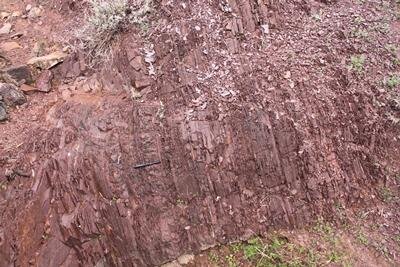Welcome to DU!
The truly grassroots left-of-center political community where regular people, not algorithms, drive the discussions and set the standards.
Join the community:
Create a free account
Support DU (and get rid of ads!):
Become a Star Member
Latest Breaking News
General Discussion
The DU Lounge
All Forums
Issue Forums
Culture Forums
Alliance Forums
Region Forums
Support Forums
Help & Search
Science
Related: About this forumChanges in Earth's orbit enabled the emergence of complex life
From phys.org:

Banded iron formation at Oraparinna, South Australia. Credit: University of Southampton
Scientists at the University of Southampton have discovered that changes in Earth's orbit may have allowed complex life to emerge and thrive during the most hostile climate episode the planet has ever experienced.
The researchers—working with colleagues in the Chinese Academy of Sciences, Curtin University, University of Hong Kong, and the University of Tübingen—studied a succession of rocks laid down when most of Earth's surface was covered in ice during a severe glaciation, dubbed 'Snowball Earth', that lasted over 50 million years. Their findings are published in the journal Nature Communications.
"One of the most fundamental challenges to the Snowball Earth theory is that life seems to have survived," says Dr. Thomas Gernon, Associate Professor in Earth Science at the University of Southampton, and co-author of the study. "So, either it didn't happen, or life somehow avoided a bottleneck during the severe glaciation."
The research team ventured into the South Australian outback where they targeted kilometre-thick units of glacial rocks formed about 700 million years ago. At this time, Australia was located closer to the equator, known today for its tropical climates. The rocks they studied, however, show unequivocal evidence that ice sheets extended as far as the equator at this time, providing compelling evidence that Earth was completely covered in an icy shell.
more ...
InfoView thread info, including edit history
TrashPut this thread in your Trash Can (My DU » Trash Can)
BookmarkAdd this thread to your Bookmarks (My DU » Bookmarks)
4 replies, 1284 views
ShareGet links to this post and/or share on social media
AlertAlert this post for a rule violation
PowersThere are no powers you can use on this post
EditCannot edit other people's posts
ReplyReply to this post
EditCannot edit other people's posts
Rec (18)
ReplyReply to this post
4 replies
 = new reply since forum marked as read
Highlight:
NoneDon't highlight anything
5 newestHighlight 5 most recent replies
= new reply since forum marked as read
Highlight:
NoneDon't highlight anything
5 newestHighlight 5 most recent replies
Changes in Earth's orbit enabled the emergence of complex life (Original Post)
Jim__
Jul 2021
OP
The article talks about changes in the orbital shape and cyclic changes in the tilt and wobble ...
Jim__
Jul 2021
#4
Wouldn't it be more the 26,000 year rotation/wobble of the Earth's 'axis'? n/t
JustFiveMoreMinutes
Jul 2021
#3
Blue Owl
(50,491 posts)1. Louie Gohmert wants to change the orbit back
He can't handle the complexities -- Gomer would rather live among the mycoplasma mycoides...
scipan
(2,356 posts)2. Would one of those changes be the solar system's
Orbit around the galaxy? It takes 225-250 million years for a full orbit so half that is around 120 million.
I'm not sure what other cycles there are.
Jim__
(14,083 posts)4. The article talks about changes in the orbital shape and cyclic changes in the tilt and wobble ...
... of the spin axis.
Earth's orbit around the sun changes its shape and the tilt and wobble of Earth's spin axis also undergo cyclic changes. These astronomical cycles change the amount of incoming solar radiation that reaches Earth's surface and, in doing so, they control climate.
"Even though Earth's climate system behaved very differently during the Snowball, Earth's orbital variations would have been blissfully unaware and just continued to do their thing," explains Professor Mitchell.
"Even though Earth's climate system behaved very differently during the Snowball, Earth's orbital variations would have been blissfully unaware and just continued to do their thing," explains Professor Mitchell.
And this site talks about Milankovitch Cycles - the same cycles referred to in the article:

Milankovitch Cycles. The Earth's orbital variation around the Sun experiences cyclic changes in shape. Eccentricity changes the shape of the orbit on a 100,000-year cycle from a circular to a more elliptical shape. Obliquity is the change of the angle of Earth's axis, which ranges from 22° to 24° from normal, and occurs on a 40,000-year cycle. Precession, commonly called the "wobble" of Earth's axis, affects the positions in Earth's orbit at which the Northern and Southern Hemispheres experience summer and winter. This changes on an approximately 20,000-year cycle.
JustFiveMoreMinutes
(2,133 posts)3. Wouldn't it be more the 26,000 year rotation/wobble of the Earth's 'axis'? n/t